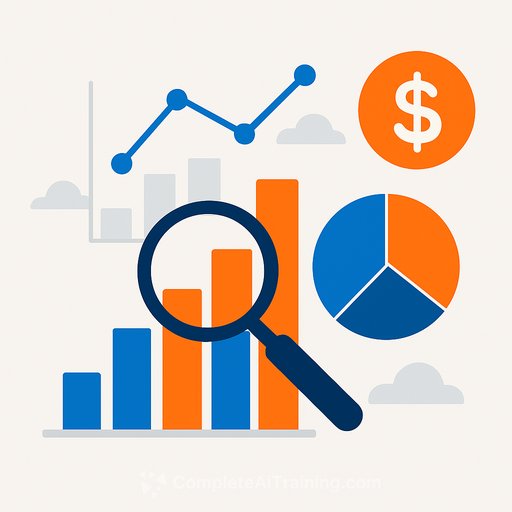AI Is Rewriting Market Plumbing - And Your Research Stack
Two signals worth your time: an AI-native research platform just raised fresh capital, and the NYSE is now handling 1.2 trillion order messages a day. Translation for finance teams: institutional research and market operations are moving to AI-first workflows with compliance, speed, and data quality at the core.
If you lead research, trading, or data, the window to standardize your AI stack is open. Here's what's changed and how to act.
Finster AI Raises $15M to Scale AI-Native Research for Banks and Asset Managers
- Funding and footprint: $15 million across Series A and seed to open a New York office, expand the London HQ, and deepen data/technology partnerships.
- What it does: An AI-native research and task automation platform built for investment banks and asset managers. Think drafting investment memos, synthesizing research, and assembling data and client materials-grounded in verifiable sources.
- Compliance-first: Strong controls and governance for confidential info and MNPI. Designed to reduce hallucinations and deliver accurate, real-time data.
- Data integrations: Third Bridge expert interviews, PitchBook for private company analysis, and Crunchbase for broader private market coverage.
"We designed Finster as a secure, scalable and verifiable platform that doesn't just support workflows; it anticipates them," said Founder and CEO Sid Jayakumar. The focus: move teams from reactive tasks to proactive, insight-led decisions at scale.
Why This Matters: DIY Chatbots Won't Clear Compliance
- Source-grounded answers: If your model can't cite, you can't defend it to clients, risk, or regulators.
- MNPI segregation: You need strict entitlements, audit trails, and approval workflows-by desk, team, and client.
- Time-to-memo becomes a KPI: Fast, accurate write-ups with linked sources will separate high-output teams from busy ones.
Market Microstructure Is Scaling to AI Speeds
The NYSE is processing ~1.2 trillion order messages daily-nearly 3x a volatile day four years ago (350 billion). That surge is driven by AI-fueled trading, algorithmic strategies, and hyper-speed participants.
- Peak week: April saw five of the top ten highest-volume days ever, capped by 30.98 billion shares on April 9 as the S&P 500 rallied 9.5%.
- Resilience: The NYSE credits its hybrid model-automation plus Designated Market Makers-for fewer trading halts (25 vs. 334 on a competing venue).
- Infrastructure: A private network and purpose-built data center (disconnected from the public internet) improve performance and cybersecurity. ICE's move to Snowflake's Data Cloud cut data costs ~50% and improved reporting speeds ~80%.
AI isn't just executing trades-it's monitoring them. Exchanges are using AI to watch flows and detect irregularities in real time. That's the standard you're being measured against, whether you operate a desk, a platform, or a risk function.
The IMF has flagged what happens when similar models chase similar signals: liquidity looks deep in calm conditions, then correlations spike under stress. More speed, more volume, more herding risk.
Action Plan: What to Do in the Next 90 Days
- Build an AI research foundation: Pilot an enterprise-grade platform with MNPI controls, source citation, and audit logs. Integrate your proprietary research, models, and entitlements.
- Tighten data contracts: Secure rights for expert interviews and private market data (e.g., Third Bridge, PitchBook, Crunchbase). Map usage by desk and geography.
- Upgrade surveillance: Add AI-based monitoring for trade flow, message bursts, and spoofing patterns. Track alert precision/recall, not just alert counts.
- Stress test operations: Run drills for trillion-message days. Check circuit-breaker behavior, failover, and human-in-the-loop decision points.
- Instrument the workflow: Measure time-to-memo, fact error rate, source coverage, and downstream impact on IC decisions and client outcomes.
Vendor Due Diligence: Questions That Save You Later
- How are answers grounded to sources? Can I replay the exact context behind each output?
- How is MNPI isolated across users, teams, and clients? What's the audit trail?
- What are the real-time guarantees (latency, freshness) across market and private data?
- Which model providers are used, and how are they evaluated for hallucinations and bias?
- What certifications and tests are in place (SOC 2, ISO, pen testing)?
KPIs Worth Tracking
- Research: time-to-first draft, revision cycles per memo, citation coverage, factual error rate, hit rate on investment theses.
- Trading/ops: messages per second handled, alert precision/recall, halt differential vs. peers, cost per TB of market data processed.
What's Next
Expect more capital flowing to AI-native platforms and more exchanges leaning on AI to keep pace. Treat AI as core infrastructure, not a side project. Clean data, strong governance, and clear metrics will compound faster than ad-hoc experiments.
Further Resources
- NYSE - market model, data, and venue structure.
- AI tools for Finance - curated options to support research, risk, and reporting.
Your membership also unlocks:





